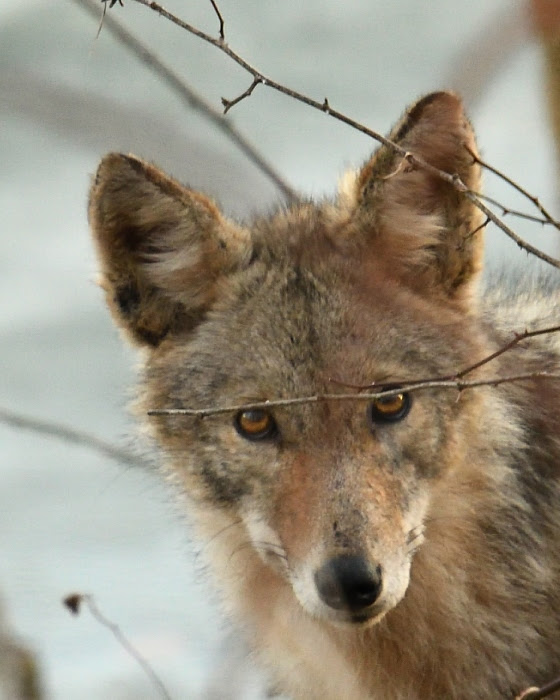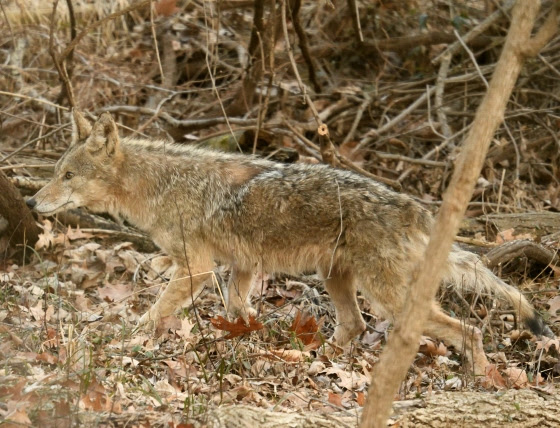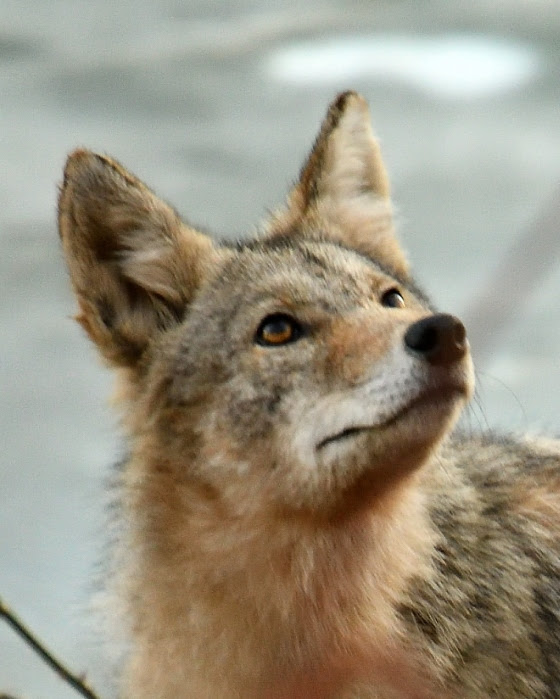Where the Coyotes Howl
Essay and photos by Joe Mish

The cold November night left a heavy coat of white frost on the still green pasture grass. The sun had just risen, though the open, west facing hillside was still shaded. Topped by a crown of red cedars, the sunlight was further delayed, but the quickly rising temperatures turned the white frost gray. A lead doe worked her way uphill to the edge of the wooded copse, where a love struck buck had earlier left his scent on an overhanging branch. The doe paused her cautious approach and stood absolutely still. Perhaps she detected an unseen buck and had second thoughts of getting too close to a over enthusiastic lothario. Her intense stare was locked on something that raised her concern. Then her tail went straight up and froze in that position while the white hair on its underside and the white hair on her rump bristled out like quills on an agitated porcupine. She remained in that position for more than a minute before she quietly turned and silently left the area, retaining her high flag and bristled rump. Typically, an alerted doe will snort, stamp her foot and do an exaggerated high stepping prance to alert her companions. This was a deviation from normal but probably just the way she conducts business. Two minutes later a coyote appeared from the dark tree line, tail tucked, and headed directly toward me. The gray frosted grass, still in the shadows, complimented the coyote in tone and color to make it appear as an apparition, exempted from earthly constraints. It stopped about twenty paces away to consider its path and trotted along the edge of a mowed strip of grass to parts unknown.
An encounter with an eastern coyote has become more common in New Jersey, the state least expected to host a living symbol of remote and wild places. More often heard than seen, the coyote makes its presence known with midnight serenades that make your hair stand on end as a chorus of howls and yips fill the night air.
It is interesting to trace the occurrence of coyotes in New Jersey and recognize the fallacies and misleading information from media and biologists, some based on politics, evolving wildlife management goals or best guess projections derived from limited available data.
The first coyote officially recorded in New Jersey was in 1939. A mid 1980s Star Ledger article, quoting a state biologist, claimed the first coyotes appeared in NJ in 1958. The same article noted the animals migrated south from New York which hosted an estimated population of 5,000 coyotes. In 2011, the New York coyote population was placed at 30,000 plus and remains stable based on current estimates. The New Jersey coyote population is given as a range of 3,000 to 6,000 animals.
Wildlife population estimates are based on the latest statistical models and surveying technology, which may explain a dramatic jump or decline in targeted populations.
At any rate, sightings in New Jersey were sporadic until the early 1970s, possibly based on misidentification, unexpected presence and a limited, but expanding coyote population.
The Star Ledger article lists a steady chronicle of coyote sightings, mostly in rural areas.
Locally, a coyote made the news in the late 1980s when it was killed by a car near the intersection of routes 28 and 22 in Bridgewater. Another was sighted and photographed in North Branch in 2004.
Today coyotes have moved into cities and towns and have been reported in all twenty-one New Jersey counties.
Local residents have digitally captured numerous coyotes in backyards and along roadsides.
This demonstrates their ability to transition from rural to suburban environs and defies the early characterization of being strictly tied to woodland and farm.
Biologists predicted, in 1985, that the ‘pioneer population’ would never reach significant levels and will remain present only while farms exist. Even data based predictions must be given latitude and considered dynamic rather than static and ironclad.
The intelligence and adaptability of the coyote cannot be underestimated. Native people held coyotes in high esteem for their trickery and explained away their elusiveness as having the ability to transition from spirit to flesh.
To conclusively define the behavior of any animal is a fool’s errand, especially with coyotes. We get the typical, ‘they avoid humans at all cost’, as the litany of coyote attacks grow. Livingston, Fairfield, Piscataway Kinnelon, Middletown and High Bridge have made headlines for attacks on humans. Not to say coyotes are stalking school bus stops and toddlers, but the possibility of an attack exists, though very uncommon. Given the number of coyotes interspersed among the dense human population, pet dogs far outpace coyotes in dog bites man headlines.
Each ‘attack’ must be examined to prevent characterizing coyotes as blood thirsty demons. Rabies is endemic in wildlife populations and known for producing aggressive behavior. Wild canines established relationships with humans to the advantage of both. So, acclimating a fox or coyote to accept handouts is a natural progression. Losing fear of humans as a result, can be misinterpreted as aggression and sign a death warrant for their learned adaptive behavior.
Somerset county set a bounty on wolves in June 1682. I cannot help but wonder if some of the wolves were crossed with coyotes.
Science does its best, though its knowledge base is constantly evolving and interpreting collected data is more of an art form and often tips objectivity to the subjective side of the scale.
Toward that end of gathering information to make better decisions, NJ Division of Fish and Wildlife is asking the public for information on coyotes and other species to help track and manage targeted wildlife populations.
Here is a survey form to collect details of a sighting. Other animals of interest are listed here as well as the coyote.
https://survey123.arcgis.com/share/e016dec1d4944495b6e99212d8ad34a4
Coyotes have their place in our ecosystem and deserve our respect and understanding, and as with most new information or situations, must be approached with an open mind.
Author Joe Mish has been running wild in New Jersey since childhood when he found ways to escape his mother’s watchful eyes. He continues to trek the swamps, rivers and thickets seeking to share, with the residents and visitors, all of the state’s natural beauty hidden within full view. To read more of his writing and view more of his gorgeous photographs visit Winter Bear Rising, his wordpress blog. Joe’s series “Nature on the Raritan, Hidden in Plain View” runs monthly as part of the LRWP “Voices of the Watershed” series. Writing and photos used with permission from the author.


